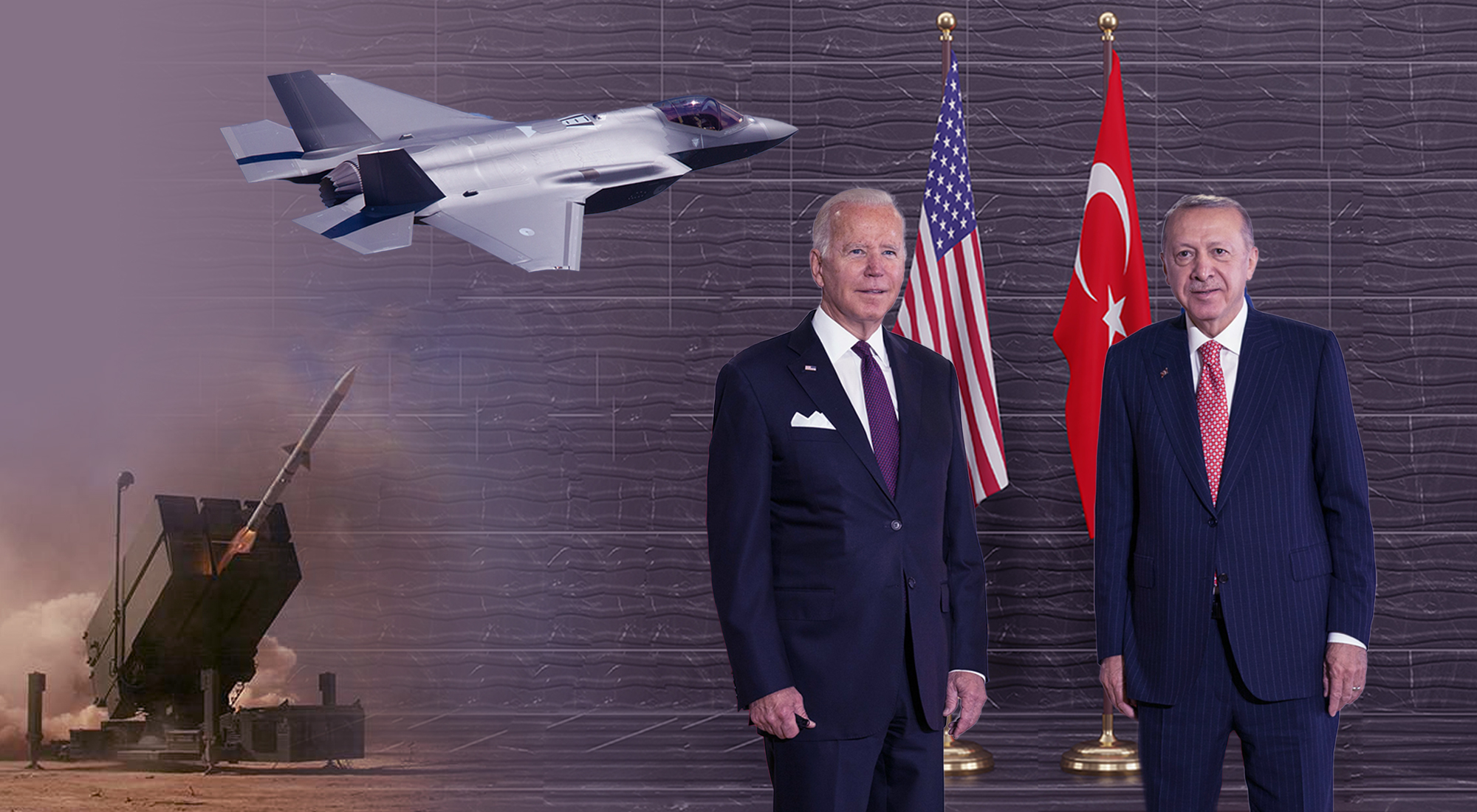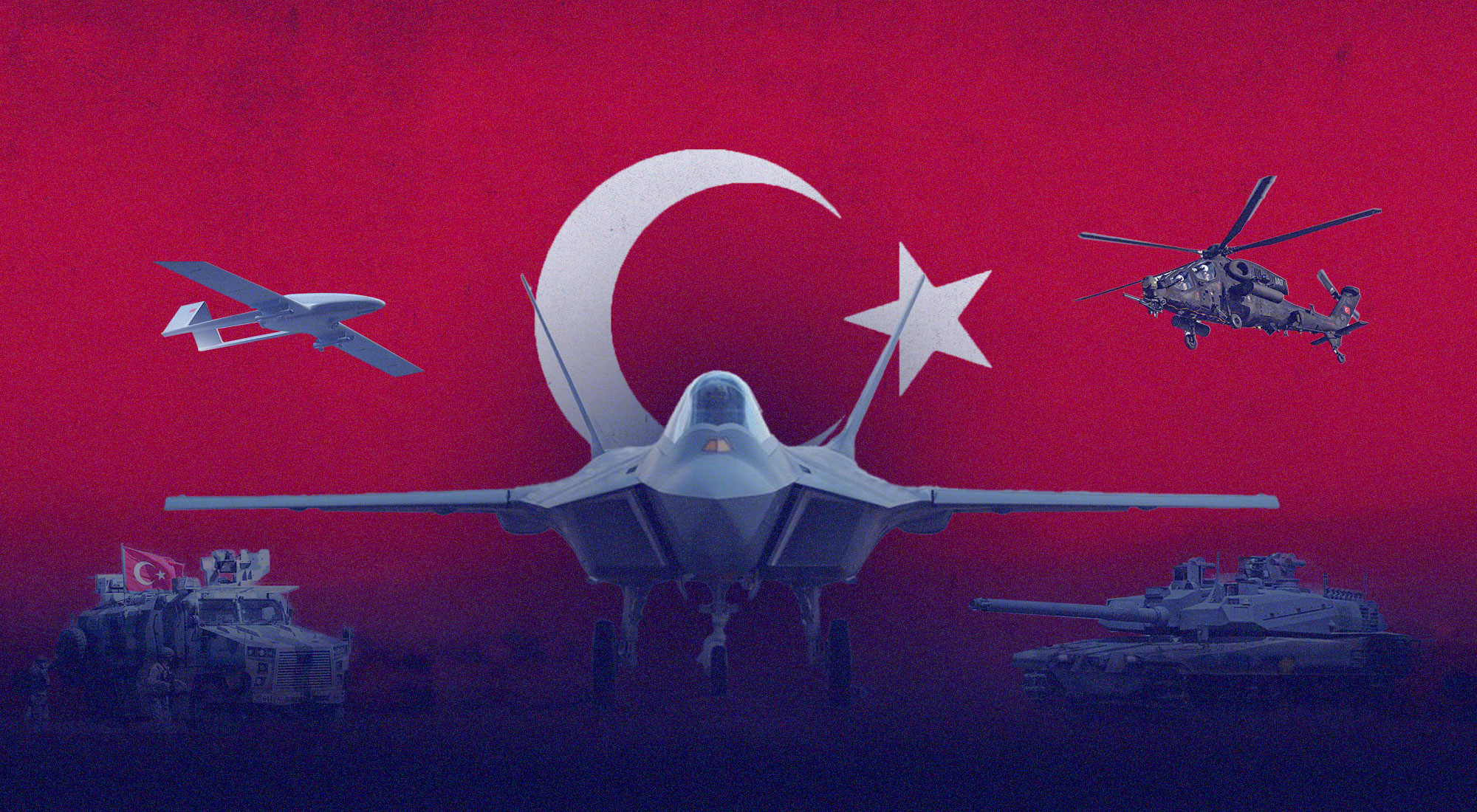Introduction
Turkey joined the United States-led F-35 advanced fifth-generation joint strike fighter program in 1999 and invested $US1.4 billion in design, co-production, and maintenance work for the consortium consisting of eight international program partners.[1] The country would buy 100 F-35As (conventional takeoff and landing) for its air force plus 20 F-35Bs (both conventional takeoff and landing or on an aircraft carrier) for its navy to place on its first indigenous light aircraft carrier/amphibious landing craft, the TCG Anadolu. Turkey would also become the regional maintenance hub for F-35 fleets in allied countries and earn at least an additional $US9 billion over the life of the program.[2]
After the failed coup attempt in 2016 against the governing Justice and Development Party (known as AKP) and President Recep Tayyip Erdoğan, Turkey re-oriented its policies to gain self-sufficiency in the arms industry and to become an intermediary between the NATO alliance and emergent powers in Eurasia. This meant the air force would embark on an arduous journey to build its own manned fighter aircrafts. Starting with the single-engine turboprop Hürkuş training-reconnaissance plane,[3] Turkish Aerospace Industries (TAI) designed the Hürjet light attack aircraft[4] and accelerated the development of Turkey’s own fifth-generation combat aircraft, TF-X.[5] These projects aimed to gradually reduce and eliminate, if possible, foreign dependency for long-term operability and durability, at least in critical components and platforms. The initial plan before 2016 was that F-35s would replace the veteran F-4 Phantoms dating from the 1960s and the oldest F-16s in the Turkish fleet from the 1980s. This stopgap would guard the skies for the next 40 years until Turkey’s indigenous platform projects could be rolled out.
Turkey’s controversial decision to procure S-400 surface-to-air missiles from Russia in 2017 put this plan in jeopardy. The U.S. government responded with an arms embargo on Turkey, and halted critical equipment, parts, and platforms, including the F-35. Ankara’s subsequent request to buy 40 F-16 Block-70 (Viper)s and 80 upgrade kits from the U.S. should be understood as the next phase of this saga. The war in Ukraine has heightened the importance of this issue for the security of NATO’s southern flank and the regional balance of power. This article will explore the underlying motives behind this precarious relationship, how it is likely to end up, and what the probable implications are for the Middle East region.
Turkey’s precarious position: Air power, missile defense systems, and Western sanctions
Ever since Turkey joined NATO in 1952, its air defense doctrine depended on U.S.-manufactured combat aircraft such as the F-100, F-104, F-4, and F-16. Crucially, the NATO defense doctrine delimited Turkey’s defense plans to only the Black Sea and appointed it as a land barrier against the Soviet Union and a possible Warsaw Pact incursion from the north. The country served as a U.S. intelligence outpost and hosted U.S. missiles with nuclear warheads to deter an all-out Soviet assault on NATO’s southern flank. During the Cuban Missile Crisis in 1962, Turkey was front and central in negotiations between the U.S, and the Soviets, who were willing to remove their nuclear missiles in Cuba in return for the removal of Jupiter missiles in Turkey. The then-Soviet Premier Nikita Khrushchev used the presence of missiles in Turkey as a negotiation ploy to rationalize his decision to arm Cuba.[6] The U.S. government’s decision to trade Turkey for Cuba regardless of Ankara’s public rejection was a major turning point in the bilateral relationship with Washington. It “shattered the sense of security in Turkey and created a long-lasting resentment and mistrust of Americans.”[7] Despite this sense of betrayal, Ankara’s commitment to the alliance survived the Cold War, and Turkey’s western port city of İzmir is still the home to NATO’s land command, headed by a three-star general. By implication, the Turkish Air Force’s basic mandate was limited to engaging enemy aircraft, suppressing enemy air defenses, and providing close air support for the army and the navy. It lacked long-range, high-altitude air and missile defense to provide protection against ballistic missiles and advanced aircraft. Its systems were comprised of Nike Hercules, Hawk, and Rapier batteries with obsolete technologies of the 1970s and ’80s.
After the end of the Cold War, Turkey faced a different kind of threat — not of land invasion but of ballistic missiles, especially from regional adversaries. Saddam Hussein threatened to hit Turkish cities with Scud missiles during the First Gulf War in 1991, Iran developed a nuclear and ballistic missile program during the mid-to-late 2000s, and the war in Syria, which began in 2011, raised the risk level even higher. Turkey decided to take two crucial steps to counter these threats. First, they approved the stationing of an X-band radar base in Malatya-Kürecik, near the eastern border, for early warning against ballistic missiles from Iran, and possibly Syria. This base is currently the most important U.S. military asset on Turkish soil. Secondly, Turkey requested that NATO place Raytheon Patriot and Eurosam SAMP-T missile-defense systems along its southern border to provide coverage against the prospect of Syrian President Bashar Al-Assad’s pre-emptive missile strikes.
The U.S. and Germany, however, withdrew their Patriot missiles after 2015 just as Russia got involved in the war, and Italy withdrew its SAMP-T missiles in 2019, leaving Turkey vulnerable to the fallout from the complex, deteriorating situation in northern Syria. France’s decision to withdraw from an earlier SAMP-T joint-development project with Turkey and Italy added salt to the wound. The Germans and Americans justified this withdrawal by claiming that the nature of the Syrian war had changed, and that the real threat was now ISIS, not Assad. This, sources said, meant missile strikes posed less of a threat.[8] Turkey’s military operations in northern Syria against the Kurdish-dominated People’s Protection Unit (YPG) also caused friction with Western partners. The U.S. and the EU do not see the YPG as a terrorist organization, even though it is an offshoot of the Kurdistan Workers Party (PKK), who are designated as terrorists. Ankara has repeatedly raised this issue at NATO and in bilateral meetings with Washington, but the U.S. sees the YPG as an ally in the fight against ISIS and provides the group with military training, logistics and support. Another point of contention is the fate of Fethullah Gülen, who heads the FETÖ (Fethullah Terrorist Organization) and has taken up refuge in the U.S. since 1999. Under his orders, Gülenists orchestrated a coup attempt in Turkey in July 2016, leading to major changes in Turkish domestic politics as well as foreign policy vis-à-vis the U.S. and the NATO alliance. The U.S. government denies any involvement by Gülen in the failed coup and refuses Turkey’s request for extradition. Another incident that created discord occurred on 24 November 2015, when the Turkish Air Force shot down a Russian SU-24 that had briefly violated Turkish airspace. The pilot ejected but was shot dead by Syrian rebels. The incident, the first time a Russian plane had been downed by NATO since the Korean War, put the AKP government under intense pressure, with Russia claiming the plane did not intrude the Turkish airspace. In an apparent sign of caution, Ankara did not invoke NATO’s Article Four, under which a member declares that its territorial integrity, political independence, or security is under threat,[9] but instead convened an extraordinary meeting with the North Atlantic Council and received verbal support of the alliance’s solidarity.[10] However, this would not translate into tangible support in terms of hardware re-deployment to Turkey.
Due to Ankara’s sense of betrayal by its allies, Turkish defense experts naturally felt a greater need to build up their own capacity and manufacture air defense missiles at home.[11] To accomplish this, Turkey needed technological know-how, which would be transferred with the purchase of Patriot PAC-3 missiles had relations with Washington been on a healthy course. This plan stalled, however, when it got mired in lengthy negotiations and the veto power of the U.S. Congress. Ankara tried to improve its air defense systems and its bargaining position toward the U.S. by showing interest in the Chinese FD-2000 air defense system with the promise of a technology transfer package, but their bid was cancelled after intense pressure from NATO in 2015. Russian President Putin also found an opportunity to draw a wedge among the ranks of the NATO alliance by reconciling with Erdoğan, who was under intense pressure after the failed coup attempt, the resulting domestic political reshuffle that empowered Eurasianists, and a geopolitical re-orientation towards securitization of foreign policy. The result of this partnership was Turkey’s purchase of the first of the two regiments of Russian S-400 Triumf air and missile defense systems for $US2.5 billion, which they would receive delivery of in 2019.
The U.S. government’s response to Turkey’s decision to buy S-400s was swift and intense. U.S. officials claimed that the S-400s might expose certain highly classified characteristics of the F-35s to Russian intelligence.[12] The argument was that S-400 could collect F-35’s radar image footprint from various angles and altitudes and thus decrease its stealth feature, while Russian maintenance operators of S-400 could hack into the F-35 through cyber warfare. Certain opinion leaders raised skepticism of such claims, and the former NATO Supreme Allied Commander Europe Adm. James Stavridis has said “it was unjust to criticize Turkey’s decision to purchase S-400s, because a lot of NATO countries have been using Russian-made systems, but only Turkey’s purchase has attracted objections.”[13] NATO Secretary-General Jens Stoltenberg stated that despite his concerns member countries have sovereign rights to decide on equipment they purchase.[14] However, there were rumors that neither the U.S. nor Israel were happy for Turkey to use the F-35’s features to design and build its TF-X, or to climb up the learning curve of aerospace technology and transfer crucial know-how to the Turkish defense industry. Despite Turkey’s request to form a joint technical committee to provide assurances and determine the interoperability of these systems within NATO standards, the U.S. administration refused to discuss the matter and ejected Turkey from the F-35 program in 2019. Moreover, it blocked delivery of four F-35A jets that had been commissioned for transfer to Turkey[15] and refused to refund the $US1.4 billion down payment. Then, the U.S. State Department withdrew its offer to sell Turkey a Patriot missile system.[16] The most politically controversial decision, however, was to impose Countering America’s Adversaries Through Sanctions Act-2017 (CAATSA) sanctions normally reserved for countries allied with Russia and engaged in malign activities. It essentially cost the Turkish defense industry billions of dollars in lost revenue by placing a ban on the export and re-export of U.S.-manufactured defense products to Turkey, prohibiting access to loans from U.S. financial institutions, and freezing assets of certain key figures such as Dr. İsmail Demir, the director of the Defense Industry Agency.
CAATSA sanctions are political in nature and applied selectively on a case-by-case basis. In contrast to the decision on Turkey, the U.S. House of Representatives “approved legislation that recommends a specific waiver under CAATSA” in 2022 for India, who had also acquired and planned to implement the S-400 system.[17] Like Turkey, India was undeterred by the threat of U.S. sanctions, but unlike Turkey, India is a key global player in Quadrilateral Security Dialogue, an informal alliance with the U.S., Australia, and Japan, formed to balance China’s influence in the Pacific and was able to ink a nuclear deal with the U.S. to facilitate cooperation in nonproliferation efforts.[18] Turkey, on the other hand, is merely a regional actor with marginal influence on Washington’s strategic calculus for Eurasia.
Turkey’s Plan B to purchase F-16 Block 70s and the politics of planes
There are two net effects of Turkey’s expulsion from the F-35 program and CAATSA sanctions on its defense industry. The first is the accelerated development of indigenous platforms such as the TF-X, MIUS (unmanned fighter jet), and TB-3 Bayraktar with foldable wings for short-range take-off and landing from the TCG Anadolu light aircraft carrier. The United Kingdom lifted all defense-related sanctions on exports to Turkey after Brexit and is co-developing the jet engine for TF-X in partnership with Rolls Royce and Kale Group. The second effect is the Turkish Air Force’s intensified effort to find a replacement aircraft to fill the 10-year gap between 2020 and 2030, when the TF-X is expected to be combat-ready. This is not an easy task, since, as mentioned earlier, Turkey’s combat fleet has been completely dependent on American-designed platforms. Since the 1980s, the air force has adopted its doctrine, training, and logistics according to a 50-year plan to operate F-16s and gradually replace the old units with a NATO-compatible fifth-generation advanced aircraft. With the F-35 program off the table, there are very few, if any, alternatives, that can provide the sought-after capability.
Despite media hype, Turkey is unlikely to buy Russian SU-35 or SU-57 fighter jets because of interoperability issues and the potential for a major fallout with NATO, considering the current war in Ukraine. Russia and Turkey have common interests, but they also clash on many fronts, from the Caucasus to Syria. Theirs is a partnership of convenience or “conflictual connivance”[19] rather than a “strategic alliance.”[20] The U.K. has positioned the Eurofighter Typhoon as an alternative option, but it is also the product of a consortium including Italy, Spain, and Germany that would require three to five years for training, combat-readiness, and logistical maintenance. It is also an expensive aircraft (in the range of $US120 million per unit) and would place pressure on Turkey’s precarious relationship with the EU. After the Former Commander in Chief of the Turkish Air Force, Gen. Hasan Küçükakyüz, visited the U.K., defense sources brushed aside rumors that Turkey is interested in the Eurofighter, saying “it’s not on our agenda.”[21] There are reports that if Turkey can resuscitate the SAMP-T joint missile defense project with France and Italy, then French Dassault Systems’ Rafale fourth-generation-plus fighter jet may become an option, but this route is also fraught with many political and technical difficulties.
That leaves Lockheed Martin’s successful F-16s, which cost about half of a Eurofighter,[22] as the only viable mid-term alternative for Turkey. Ankara has 238 F-16 C (single-seat)/D (double-seat) aircraft in its inventory, which consists of Block 30, Block 40, and Block 50 models, and some Block 50+s The main differences between these blocks are engine power, radar coverage, and mission type. Specifically, Block 30 is designed for short-range air-to-air missions and dogfights; Block 40 carries Low Altitude Navigation and Targeting InfraRed for Night pods for air-to-ground missions; Block 50 carries anti-radiation missiles for Suppression of Enemy Air Defense missions; and Block 50+ has more advanced radar and conformal fuel tanks for extended range in all types of missions. Under the Özgür Project, TAI began to replace foreign-supplied critical aircraft components with their local substitutes. This involves modernization of the older Block 30s with home-grown mission-computer, avionics, and software, including mid-life-extension from 8,000 to 12,000 flight hours. An important component of the upgrade is to develop and integrate the indigenous Active Electronically Scanned Array radar to Block 30 F-16s from 2023 onwards.[23] This will later be extended to Block 40s so that the air force can maintain its fleet of fourth-generation aircraft until 2030.
Turkey might have sufficient air power if it were in a less tumultuous region of the world but given the ongoing tensions with its historic rivals Greece and the Republic of Cyprus on a vast array of issues from territorial rights to air space, Turkey must keep its air force up-to-date and well-trained to prevent strategic losses of its key interests. Greece is upgrading 84 of its F-16s to the latest Block 70 (Viper) model and purchasing 24 Rafale jets from France, and may receive more than 20 F-35s from the U.S. starting in 2028. If Turkey does nothing until the rollout of its TF-X in 2030s, Greece is likely to gain a major edge over Turkey in the skies. To prevent such an outcome, Turkey sent a Letter of Request to the Pentagon in October 2021 to procure 40 brand new F-16 Block 70s and 80 modernization kits to upgrade some of its older F-16s for $US7 billion in total. If the bid goes through, it would be a bridge solution for Turkey to maintain the balance in the Aegean and the Eastern Mediterranean for the next decade.
On an unofficial basis, sources claim that U.S. President Biden pledged to support Turkey’s request to the Pentagon if Turkey lifts its veto against Sweden and Finland joining NATO, but the Congress remains as the main obstacle to a deal. Under the Arms Export Control Act, the Congress can prevent Turkey from purchasing the F-16s. The powerful Greek lobby in Washington vowed to block the sale, citing Turkey’s alleged overflights and violation of Greek airspace in the Aegean. In July 2022, the House of Representatives approved in a 244 to 179 vote to place restrictions on the sale of F-16s to Turkey in an amendment to the National Defense Authorization Act (NDAA). The amendment, led by Democratic Senator Chris Pappas, sets two preconditions for approval of the sale:
- It must be essential to U.S. national security.
- The President must certify to the appropriate congressional committee that during the preceding 120-day period “Turkey has not violated 1) the sovereignty of Greece, including territorial overflights 2) International Civil Aviation Organization’s (ICAO) Athens Flight Information Region (FIR).”[24]
Although Turkey’s planned assault in northern Syria on the YPG/PKK may complicate the issue for Washington, U.S. President Biden stated at the Madrid NATO summit in June 2022 that the sale of F-16s serves U.S. national interests. The war in Ukraine necessitates a bolder posture by NATO on its eastern flank, and Turkey’s geopolitical value is therefore heightened. It is the second condition that presents problems for Turkey. The U.S. State Department issued a report (see letter below) to the Congress in 2020 stating that it is unable to provide a confirmed list of violations of Greece’s airspace. One reason is that there is no clarity on the extent of territorial airspace rights in the Aegean since Greece claims a 10-mile airspace over 6 miles of territorial waters, which the U.S. does not recognize. There are also many “gray zones,” which are islands, islets, or rocks not clearly delineated in international agreements. Lacking an agreed boundary, it is technically infeasible to ascertain violations of Greece’s national airspace. A final sticking point is that the ICAO concerns only civilian air traffic per Article 3 and not military aircraft. The Turkish Air Force or any other military is not bound to submit flight plans before entering the Athens FIR.[25]
In short, the preconditions are empty promises, or, as Sinan Ülgen, director of the Istanbul-based think tank EDAM, argues, “they provide vast maneuverability for the White House” to approve the sale.[26] Given the upcoming mid-term elections in the U.S. this November, the Biden administration is unlikely to devote much attention to either Turkey’s request for F-16s or Greece’s for F-35s. Both sales require approval of the Senate, the House of Representatives, and the White House. If Republicans win a majority in Congress, then Washington’s calculus will change, and negotiations may be protracted. Despite reports that the Pentagon “expedited purchase procedures for the sale of F-35s to Greece,”[27] most likely, the U.S. administration will defer a final decision on the sale of both F-16s and F-35s until after the presidential elections in Turkey and parliamentary elections in Greece next year.
The US State Department’s Response to the Congress on Airspace Rights, 2020

Source: The US Congressional Archives, 2020
Conclusion
The F-35 fighter jet issue represents much more than Turkey’s air defense. It is symbolic of the country’s relationship with the U.S. and NATO, and is tied into Turkey’s geopolitical status – not only its importance as a regional power, but also its perceived insecurity. Should the U.S. sell the F-16 Block 70 to Turkey, it could signal a welcome compromise in these uncertain times. If they choose not to, Turkey will probably drift further away from the NATO alliance and form a closer partnership with Russia and China.
The NATO summit in Madrid was a turning point where Turkey re-affirmed its place in the Western alliance and its interest to continue to have a working relationship with the U.S. In return, Turkey agreed to lift its veto over Sweden and Finland’s membership. Greece’s effort to block the sale of F-16s to Turkey is unlikely to succeed since the NDAA amendment is open to interpretation and contains clauses that the U.S. could not feasibly fulfill. The fighter jet issue will not be settled until after mid-term elections in the U.S. in November 2022 and presidential elections in Turkey in June 2023, but it could affect Turkey, given its precarious position in the regional security architecture, for the foreseeable future.
References
[1] “F-35 Global Partnership,” Lockheed Martin, https://www.lockheedmartin.com/en-us/products/f-35/f-35-global-partnership.html.
[2] Aaron Mehta, “Turkey Officially Kicked Out of F-35 Program, Costing US Half a Billion Dollars,” Defense News (blog), July 17, 2019, https://www.defensenews.com/air/2019/07/17/turkey-officially-kicked-out-of-f-35-program/.
[3] Turkish Aerospace, “HÜRKUŞ: New Generation Basic Trainer Aircraft,” https://www.tusas.com/en/products/aircraft/indigenous-development/hurkus (accessed July 2022).
[4] Turkish Aerospace, “HÜRJET: Advanced Jet Trainer and Light Attack Aircraft,” https://www.tusas.com/en/products/new-projects/original-development/hurjet (accessed July 2022).
[5] Turkish Aerospace, “TF-X,” https://www.tusas.com/en/products/new-projects/original-development/tf (accessed July 2022).
[6] Graham T. Allison and Zelikow Philip, Essence of Decision: Explaining the Cuban Missile Crisis, Second Edition (New York, NY: Addison-Wesley Educational Publishers Inc., 1999): 241.
[7] Jennifer Schaffer, “The Turkish Missile Crisis: The Root of Anti-American Sentiment in Turkey,” Turkish Heritage Organization, March 31, 2020, https://medium.com/meddah-a-u-s-turkey-storytelling-project/the-turkish-missile-crisis-the-root-of-anti-american-sentiment-in-turkey-6e7258e8975.
[8] Metin Gürcan, “US Plays Politics with Patriot Missile Removal,” Al-Monitor, August 20, 2015, https://www.al-monitor.com/originals/2015/08/turkey-germany-patriots-controversial-arrival-controversial.html.
[9] “NATO Calls ‘Extraordinary Meeting’ After Turkey Downs Russian Jet,” NDTV, November 24, 2015, https://www.ndtv.com/world-news/nato-calls-extraordinary-meeting-after-turkey-downs-russian-jet-1247062.
[10] NATO, “Statement by the NATO Secretary General after the Extraordinary NAC Meeting,” Press Release, November 24, 2015, https://www.nato.int/cps/en/natohq/news_125052.htm.
[11] Jim Townsend and Rachel Ellehuus, “The Tale of Turkey and the Patriots,” War on the Rocks, July 22, 2019, https://warontherocks.com/2019/07/the-tale-of-turkey-and-the-patriots/.
[12] “Turkey, the S-400 and the F-35,” Strategic Comment 22, Vol. 25 (London: IISS, August 2019), https://www.iiss.org/publications/strategic-comments/2019/turkey-the-s400-and-the-f35.
[13] “Criticism of Turkey’s S-400 Purchase Unjust, Former NATO Commander Says,” Daily Sabah, February 1, 2019, https://www.dailysabah.com/politics/2019/02/01/criticism-of-turkeys-s-400-purchase-unjust-former-nato-commander-says.
[14] NATO, “Remarks by NATO Secretary General Jens Stoltenberg at the Joint Press Point with the Prime Minister of Montenegro, Zdravko Krivokapić,” December 15, 2020, http://www.nato.int/cps/en/natohq/opinions_180095.htm.
[15] Yörük Işık, “CAATSA Sanctions Are Hurting Turkey’s Military Readiness at a Time When NATO Can’t Afford It,” Middle East Institute, May 6, 2021, https://www.mei.edu/publications/caatsa-sanctions-are-hurting-turkeys-military-readiness-time-when-nato-cant-afford-it.
[16] Ryan Browne, “US Formally Pulls Turkey’s Patriot Missile System Offer,” CNN, August 22, 2019, https://www.cnn.com/2019/08/22/politics/turkey-patriot-missiles-us/index.html.
[17] “No CAATSA Sanctions on India – After Historic Nuclear Deal, US ‘Approves’ CAATSA Waiver For India,” The Eurasian Times, July 15, 2022, https://eurasiantimes.com/no-caatsa-sanctions-us-approves-caatsa-waiver-to-india/.
[18] Jayshree Bajoria and Esther Pan, “The U.S.-India Nuclear Deal,” Council on Foreign Relations, November 5, 2010, https://www.cfr.org/backgrounder/us-india-nuclear-deal.
[19] Marc Pierini, “Russia’s Posture in the Mediterranean: Implications for NATO and Europe,” Carnegie Europe, June 8, 2021, https://carnegieeurope.eu/2021/06/08/russia-s-posture-in-mediterranean-implications-for-nato-and-europe-pub-84670.
[20] Yury Barmin, “The Power Balances in the Middle East,” 5th Istanbul Security Conference (Istanbul, Turkey, 7 November 2019).
[21] “Türkiye Eurofighter Uçağı Alacak Mı?,” CNN TÜRK [Turkish], June 24, 2022, https://www.cnnturk.com/video/dunya/turkiye-eurofighter-ucagi-alacak-mi.
[22] Valius Venckunas, “Top 10 Most Expensive Fighter Jets in 2021,” Aerotime Hub, March 27, 2021, https://www.aerotime.aero/articles/27553-Top-10-most-expensive-fighter-jets-in-2021.
[23] Kaan Azman, “F-16 ÖZGÜR Modernizasyonunda Seri Üretim Uşamasına Üeçildi,” DefenceTurk [Turkish], June 2, 2022, https://www.defenceturk.net/f-16-ozgur-modernizasyonunda-seri-uretim-asamasina-gecildi.
[24] Laura Kelly, “House Democrat Targets F-16 Sales to Turkey over Greek Security Concerns,” The Hill, July 11, 2022, https://thehill.com/policy/defense/3553391-house-democrat-targets-f-16-sales-to-turkey-over-greek-security-concerns/.
[25] Hüseyin Fazla, “Yunan İddialarına Karşı Türkiye’nin Cevapları: Bölüm-5,” Strasam [Turkish], June 30, 2022, https://strasam.org/ua-iliskiler/uluslararasi-sorunlar/yunan-iddialarina-karsi-turkiyenin-cevaplari-bolum-5-942.
[26] Sinan Ulgen [@sinanulgen1], “1. İlk bakışta olumsuz bir karar olarak gözükse de detaylı olarak incelediğimde kanaatim değişti. Şöyle ki, karar aslında idareye büyük bir manevra alanı tanıyor,” Twitter Post [Turkish], July 14, 2022, https://twitter.com/sinanulgen1/status/1547681396130385920.
[27] Vassilis Nedos, “F-35 Purchase Procedures Expedited,” EKathimerini,” August 6, 2022, https://www.ekathimerini.com/news/1190612/f-35-purchase-procedures-expedited/.








